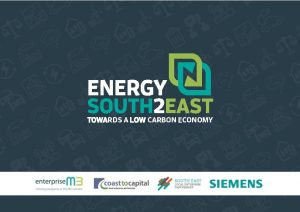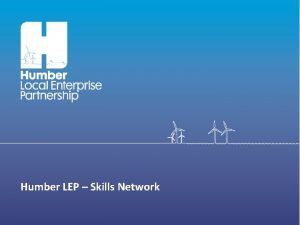Tim Wates Chair Coast to Capital LEP WELCOME




















































- Slides: 52


Tim Wates Chair, Coast to Capital LEP WELCOME

Katherine Wright Deputy Director, Public Sector and Local, BEIS NATIONAL ENERGY CONTEXT

Dave Axam Chair, Enterprise M 3 LEP THE IMPORTANCE OF COLLABORATION

PARTNERSHIPS

TAKING THE FIRST STEP

FUNDING


Carl Ennis Managing Director, Siemens Energy Management SOUTH 2 EAST ENERGY STRATEGY

South 2 East Energy Strategy Carl Ennis, Managing Director Siemens Energy Management

Siemens and the UK in numbers 59, 000 jobs supported £ 3 m donations per year £ 3. 5 bn value added to UK economy 200 research projects ongoing including the landmark Triangulum project £ 18. 4 m £ 5 bn £ 1. 8 bn economic value of education programmes revenue generated investment in UK supply chain 15 manufacturing sites 97% 22, 000 waste recycled 15, 000 employees supply chain jobs 20% tax paid in profits Top 5 engineering employer

Siemens: Ingenuity in the UK

Siemens commitment to decarbonisation – carbon neutrality by 2030 Siemens will halve its own 2014 carbon emissions by 2020 … 2. 2 million tons -50% -100% Over € 100 m is being invested in measures to reduce direct and indirect carbon emissions Drive Energy Efficiency Program Increase energy efficiency in factories as well as new constructions Leverage Distributed Energy Systems Optimize energy costs and leverage CO 2 footprint of decentralized systems Electricity Reduce Fleet emissions Utilizing potential of low emission cars in fleet, including e-Car potential Heating/ Process heat Fleet Other 2014 2020 2030 … and will be CO 2 neutral by 2030 Purchase Green Energy Move towards a significantly cleaner power mix with a strong focus on renewable energies and high efficient gas

How the Energy trilemma drives Energy Strategy for South East England Strategic Objectives Economic growth • • Identify potential investment opportunities • Attract investors and create jobs Enable the tri-LEP region to decarbonise • Position the tri-LEP region as a centre for innovation in the low carbon sector • Foster clean growth across the region • Ensure that all energy produced is clean and low-carbon energy • Ensure that local people and society are beneficiaries of the energy strategy Climate Change • Exceed the CC requirements • Improve air quality Energy independence • Self sustainable low carbon energy schemes • Energy as universal services

Can the Energy Strategy meet our Climate Change targets? The Committee on Climate Change (2016, Progress Report to Parliament): Sector-wise Decarbonisation from 1990 to 2016 80% 70% 60% 50% 40% 30% 20% 10% as te as es Fg LU ul tu re & Bu Ag ric W LU C F gs ild in rt ns po Tr a ry st du In w er 0% Po UK greenhouse gas emissions, assuming no additional policy or regulation aimed at reducing emissions

The tri-LEP Energy Strategy for South East England sets the following course. . . Moving from evolutionary… - Diversification to enhance and accelerate the local energy economy, with increase in GVA arising from job growth in low-carbon technology No intervention - Other local planning and strategies unaffected or even enhanced - Innovation and new opportunities that need significant investment in new skills / training Mt. CO 2 …to revolutionary! Evolutionary intervention Target: 80% reduction against 1990 Revolutionary development 1990 2015 2032 2050 - Hydrogen networks for heating, transport and process industry - Implement circular economy across transport and residential sectors - Smart Energy Efficiency to move beyond net zero carbon into self-generation

Who benefits from the centralised cost of energy? Energy Independence… 36. 17% Almost 2/3 of the energy bill is not the energy itself: this value leaves the region 25. 44% https: //www. ofgem. gov. uk/dataportal/breakdown-dual-fuel-bill

The drivers of the tri-LEP energy strategy themes Trends Tri-LEP 5 Priority Themes Decarbonization Low carbon heating Decentralization Energy Saving and Efficiency Digitalization Future Energy Renewable Generation Democratisation Smart Energy System Cost-effective Clean Growth Transport Revolution

What the energy strategy is for The strategy reflects energy -related aspects of the Industrial Strategy Responds to national trajectory for decarbonisation and clean growth Makes reference to other national and local energy and low carbon policy. “In addition to providing a strategic framework that informs the actions which LEPs and their partners take on energy, the LEP energy strategies should provide a valuable evidence base for use by central government. ” BEIS 2017

National Policy Context Climate Change Act (2008) Legally binding target to reduce emissions by 80% by 2050 Industrial Strategy (2017) government’s plan to shape a stronger, fairer economy. Clean Growth Strategy (2017) plan to cut emissions, reduce cost and increase efficiency Smart Power Report NIC’s proposals for the UK’s future energy system Cost of Energy Report (2017) Prof. Dieter Helm’s analysis of how and why we pay too much for energy

Energy. South 2 East Strategy Pathway Renewables Strategy Development Energy Efficiency Smart Transport Non-technical Interventions Str ate g y Heat

Some of the key challenges for the tri-LEP region 1. Electrical grid constraint prevents growth and development 2. Lots of heat is being wasted by industry and lots of homes are burning oil 3. 20% of homes are not connected to the gas grid 4. The economic value of the energy produced in the tri-LEP region is not retained 5. There are real concerns around air quality and emissions

Some of the key opportunities for the tri-LEP region 1. Significant renewable potential 2. Rich in natural assets 3. Large amount of development taking place 4. Key sectors are already engaging 5. New technology digitalisation, decentralisation and democratisation is becoming viable

The 5 Key Themes and 18 Project Models 1 District Heat Networks rollout 2 Off-gas grid homes 4 Offshore wind development 5 Solar and microgrid on landfill sites 12 EV charging & hydrogen-fuelling infrastructure 2 Off-gas grid homes 9 Energy Efficiency in homes 5 Solar and microgrid on landfill sites 11 Housing and community microgrids 13 CNG fleet fuelling 3 Hydrogen injection into the Natural Gas grid 10 SME Support Programme 6 Biomass fuel supply chain development 12 EV charging & hydrogen-fuelling infrastructure 14 Ports modernisation of energy infrastructures 7 Solar energy for Network Rail 15 Setup of ESCO / MUSCO infrastructure 8 Car parks - solar potential 18 Support developments in CO 2 capture 16 New-build homes on hydrogen grid 17 Biofuel evolution

Scale-up and extension of Project Models Power 2050 Heating Novel RES Demand response Storage On-shore wind District heating Aggregation Micro-grids Industrial energy efficiency PV E-highway Heat pumps High power DC Modal shift Solar thermal Today E-buses Off-grid solutions Residential energy efficiency EV Transport Utilisation of heat sources Hydrogen Charging infrastructure CNG Public transport Bio-fuel production and conversion Pre-payment and switching Insulation on homes and buildings Congestion charging Carbon pricing Cross-cutting and non-technological

Integrated thinking between the public and private sector Economic Growth… Significant social and community value-add from smart and integrated energy systems Traditional Energy Schemes Microgrid Community CO 2 Energy Cost Resilience Carbon Reduction Estate Management Innovation C&I Collaboration Training And Skills Quality of Life

Project Model #4: Offshore wind development Rampion Project ‒Stretches from East Worthing to Brighton ‒Covers 72 square kilometers with 116 turbines ‒Will power the equivalent of half the homes in Sussex from the 400 MW capacity Scale-up Address blockers in the large-scale development by encouraging developers with a viable project pipeline and local support structures As LEPs. . . Encourage investors and supplychain businesses Drive upgrade of the electricity grid for injection of offshore-wind energy Secure training and retain generated value within the region

Project Model #5: Solar and Microgrid on Landfill Sites Westhampnett Solar Farm ‒ West Sussex County Council’s publicly-owned solar farm opened in October 2018 ‒ 26, 000 panels delivering 7. 4 MW with on-site batteries ‒ Equivalent to powering 2, 400 households. A similar scheme generates income for the Council of £ 13. 8 M and paying-back in under 10 years Scale-up Consortium of Local Authorities with Landfill development portfolio ready for investment by low risk funders Utilising Land that is contaminated and currently not ready for development and creating or securing 4000 jobs

In summary, the Local Energy Strategy and Action Plan for the South East…

Siemens and the UK in numbers 59, 000 jobs supported £ 3 m donations per year £ 3. 5 bn value added to UK economy 200 research projects ongoing including the landmark Triangulum project £ 18. 4 m £ 5 bn £ 1. 8 bn economic value of education programmes revenue generated investment in UK supply chain 15 manufacturing sites 97% 22, 000 waste recycled 15, 000 employees supply chain jobs 20% tax paid in profits Top 5 engineering employer

Siemens: Ingenuity in the UK

Siemens commitment to decarbonisation – carbon neutrality by 2030 Siemens will halve its own 2014 carbon emissions by 2020 … 2. 2 million tons -50% -100% Over € 100 m is being invested in measures to reduce direct and indirect carbon emissions Drive Energy Efficiency Program Increase energy efficiency in factories as well as new constructions Leverage Distributed Energy Systems Optimize energy costs and leverage CO 2 footprint of decentralized systems Electricity Reduce Fleet emissions Utilizing potential of low emission cars in fleet, including e-Car potential Heating/ Process heat Fleet Other 2014 2020 2030 … and will be CO 2 neutral by 2030 Purchase Green Energy Move towards a significantly cleaner power mix with a strong focus on renewable energies and high efficient gas

How the Energy trilemma drives Energy Strategy for South East England Strategic Objectives Economic growth • • Identify potential investment opportunities • Attract investors and create jobs Enable the tri-LEP region to decarbonise • Position the tri-LEP region as a centre for innovation in the low carbon sector • Foster clean growth across the region • Ensure that all energy produced is clean and low-carbon energy • Ensure that local people and society are beneficiaries of the energy strategy Climate Change • Exceed the CC requirements • Improve air quality Energy independence • Self sustainable low carbon energy schemes • Energy as universal services

Can the Energy Strategy meet our Climate Change targets? The Committee on Climate Change (2016, Progress Report to Parliament): Sector-wise Decarbonisation from 1990 to 2016 80% 70% 60% 50% 40% 30% 20% 10% as te as es Fg LU ul tu re & Bu Ag ric W LU C F gs ild in rt ns po Tr a ry st du In w er 0% Po UK greenhouse gas emissions, assuming no additional policy or regulation aimed at reducing emissions

The tri-LEP Energy Strategy for South East England sets the following course. . . Moving from evolutionary… - Diversification to enhance and accelerate the local energy economy, with increase in GVA arising from job growth in low-carbon technology No intervention - Other local planning and strategies unaffected or even enhanced - Innovation and new opportunities that need significant investment in new skills / training Mt. CO 2 …to revolutionary! Evolutionary intervention Target: 80% reduction against 1990 Revolutionary development 1990 2015 2032 2050 - Hydrogen networks for heating, transport and process industry - Implement circular economy across transport and residential sectors - Smart Energy Efficiency to move beyond net zero carbon into self-generation

Who benefits from the centralised cost of energy? Energy Independence… 36. 17% Almost 2/3 of the energy bill is not the energy itself: this value leaves the region 25. 44% https: //www. ofgem. gov. uk/dataportal/breakdown-dual-fuel-bill

The drivers of the tri-LEP energy strategy themes Trends Tri-LEP 5 Priority Themes Decarbonization Low carbon heating Decentralization Energy Saving and Efficiency Digitalization Future Energy Renewable Generation Democratisation Smart Energy System Cost-effective Clean Growth Transport Revolution

What the energy strategy is for The strategy reflects energy -related aspects of the Industrial Strategy Responds to national trajectory for decarbonisation and clean growth Makes reference to other national and local energy and low carbon policy. “In addition to providing a strategic framework that informs the actions which LEPs and their partners take on energy, the LEP energy strategies should provide a valuable evidence base for use by central government. ” BEIS 2017

National Policy Context Climate Change Act (2008) Legally binding target to reduce emissions by 80% by 2050 Industrial Strategy (2017) government’s plan to shape a stronger, fairer economy. Clean Growth Strategy (2017) plan to cut emissions, reduce cost and increase efficiency Smart Power Report NIC’s proposals for the UK’s future energy system Cost of Energy Report (2017) Prof. Dieter Helm’s analysis of how and why we pay too much for energy

Energy. South 2 East Strategy Pathway Renewables Strategy Development Energy Efficiency Smart Transport Non-technical Interventions Str ate g y Heat

Some of the key challenges for the tri-LEP region 1. Electrical grid constraint prevents growth and development 2. Lots of heat is being wasted by industry and lots of homes are burning oil 3. 20% of homes are not connected to the gas grid 4. The economic value of the energy produced in the tri-LEP region is not retained 5. There are real concerns around air quality and emissions

Some of the key opportunities for the tri-LEP region 1. Significant renewable potential 2. Rich in natural assets 3. Large amount of development taking place 4. Key sectors are already engaging 5. New technology digitalisation, decentralisation and democratisation is becoming viable

The 5 Key Themes and 18 Project Models 1 District Heat Networks rollout 2 Off-gas grid homes 4 Offshore wind development 5 Solar and microgrid on landfill sites 12 EV charging & hydrogen-fuelling infrastructure 2 Off-gas grid homes 9 Energy Efficiency in homes 5 Solar and microgrid on landfill sites 11 Housing and community microgrids 13 CNG fleet fuelling 3 Hydrogen injection into the Natural Gas grid 10 SME Support Programme 6 Biomass fuel supply chain development 12 EV charging & hydrogen-fuelling infrastructure 14 Ports modernisation of energy infrastructures 7 Solar energy for Network Rail 15 Setup of ESCO / MUSCO infrastructure 8 Car parks - solar potential 18 Support developments in CO 2 capture 16 New-build homes on hydrogen grid 17 Biofuel evolution

Scale-up and extension of Project Models Power 2050 Heating Novel RES Demand response Storage On-shore wind District heating Aggregation Micro-grids Industrial energy efficiency PV E-highway Heat pumps High power DC Modal shift Solar thermal Today E-buses Off-grid solutions Residential energy efficiency EV Transport Utilisation of heat sources Hydrogen Charging infrastructure CNG Public transport Bio-fuel production and conversion Pre-payment and switching Insulation on homes and buildings Congestion charging Carbon pricing Cross-cutting and non-technological

Integrated thinking between the public and private sector Economic Growth… Significant social and community value-add from smart and integrated energy systems Traditional Energy Schemes Microgrid Community CO 2 Energy Cost Resilience Carbon Reduction Estate Management Innovation C&I Collaboration Training And Skills Quality of Life

Project Model #4: Offshore wind development Rampion Project ‒Stretches from East Worthing to Brighton ‒Covers 72 square kilometers with 116 turbines ‒Will power the equivalent of half the homes in Sussex from the 400 MW capacity Scale-up Address blockers in the large-scale development by encouraging developers with a viable project pipeline and local support structures As LEPs. . . Encourage investors and supplychain businesses Drive upgrade of the electricity grid for injection of offshore-wind energy Secure training and retain generated value within the region

Project Model #13: Compressed Natural Gas (CNG) fleet rollout Converting Council refuse fleets ‒ Move to CNG as a prime fuel with 30% cost saving per mile ‒ 20% reduction in emissions over diesel fuel ‒ 95% CO 2 savings when using bio-methane ‒ Unused high-pressure gas pipeline to act as CNG feed ‒ Quieter and improved air quality Investment Consortium of Local Authorities investing or specifying CNG fleets will help unlock supply chain and private CNG fleets (haulage, warehousing, supermarkets) Transport Alternative decarbonization pathway in the event that electrification / battery / storage is insufficient for large or heave vehicle fleets

In summary, the Local Energy Strategy and Action Plan for the South East…

Adam Bryan Managing Director, South East LEP IMPORTANCE OF ENERGY TO BUSINESS

Chris Seamark LOCASE LOCAL ENERGY CASE STUDY

Tom Coates West Sussex County Council LOCAL ENERGY CASE STUDY

Tim Wates Chair, Coast to Capital LEP CLOSING REMARKS
 Nick wates
Nick wates Lep sidney
Lep sidney Lep l
Lep l Clarence valley lep
Clarence valley lep Lep workshop
Lep workshop Tomi lep
Tomi lep Lep
Lep Lep module
Lep module Lep jules antonini
Lep jules antonini South east midlands lep
South east midlands lep Sadnut niekomu na lep vyznam
Sadnut niekomu na lep vyznam Wise men three clever are we
Wise men three clever are we Net working capital refers to which of the following
Net working capital refers to which of the following Regulatory capital vs economic capital
Regulatory capital vs economic capital Source of capital reserve
Source of capital reserve Constant vs variable capital
Constant vs variable capital Difference between capital reserve and reserve capital
Difference between capital reserve and reserve capital Multinational capital structure
Multinational capital structure Multinational cost of capital and capital structure
Multinational cost of capital and capital structure Basle ii
Basle ii Capital allocation line vs capital market line
Capital allocation line vs capital market line Think outside the chair
Think outside the chair Empty chair technique worksheet
Empty chair technique worksheet Cylinder on isometric paper
Cylinder on isometric paper Bob ics
Bob ics Goldilocks was very tired now en español
Goldilocks was very tired now en español There is a book on the chair
There is a book on the chair Contest chair
Contest chair Stereochemistry of alkanes and cycloalkanes
Stereochemistry of alkanes and cycloalkanes Cvpr borderline
Cvpr borderline Airdock chair
Airdock chair Chair sit and reach test
Chair sit and reach test Keith haring blue chair
Keith haring blue chair Haines chair
Haines chair Sorrento seating matters
Sorrento seating matters Biscuits is countable or uncountable
Biscuits is countable or uncountable Cozzia 16018 massage chair
Cozzia 16018 massage chair Workplace safety
Workplace safety Jean monnet chair
Jean monnet chair Sarah e goode
Sarah e goode William s grant curtain rod support
William s grant curtain rod support A two-dimensional area with a recognizable boundary
A two-dimensional area with a recognizable boundary It's a _________pencil
It's a _________pencil Mngel
Mngel Wiggle side chair history
Wiggle side chair history Once upon a time there were three bears
Once upon a time there were three bears Iccv duties
Iccv duties Cavity wall dental definition
Cavity wall dental definition It's a _________pencil
It's a _________pencil Joseph kosuth: one and three chair barnett newman
Joseph kosuth: one and three chair barnett newman Office chair quotation
Office chair quotation Drawing chair conformations
Drawing chair conformations Bariatric dental chair
Bariatric dental chair











































































